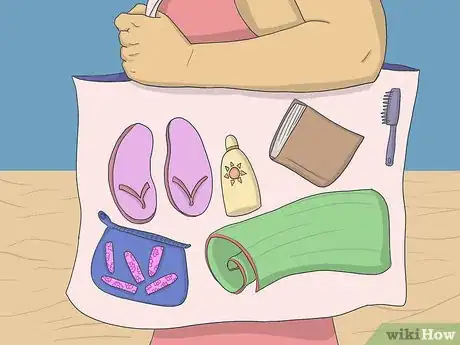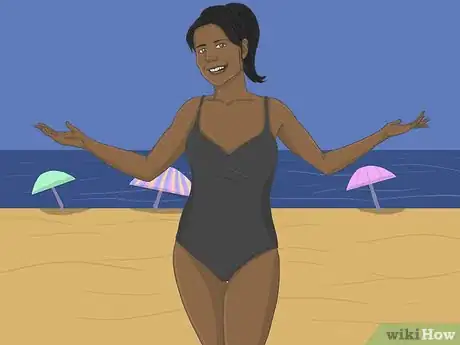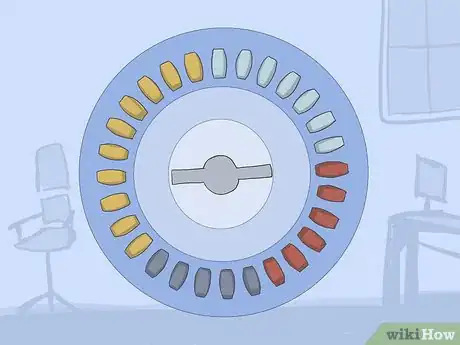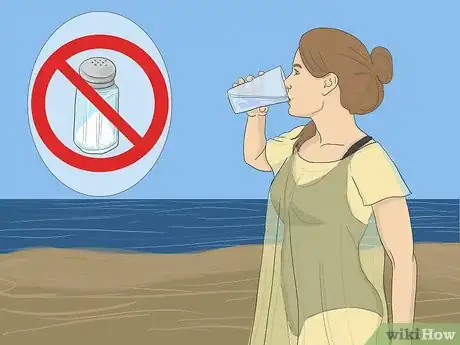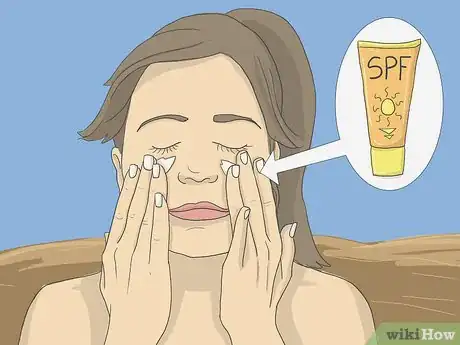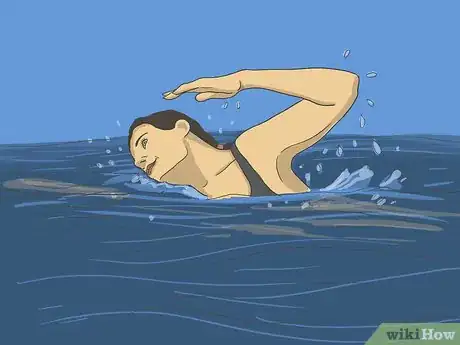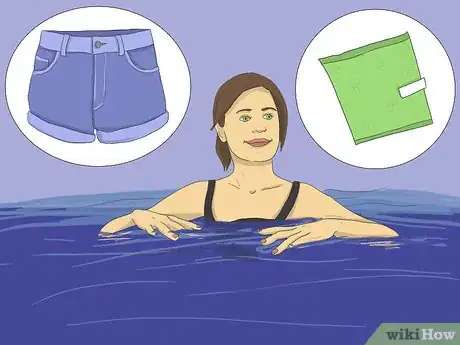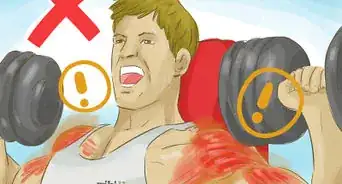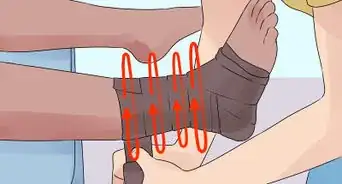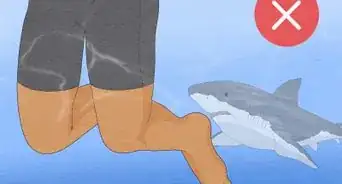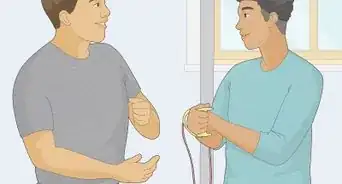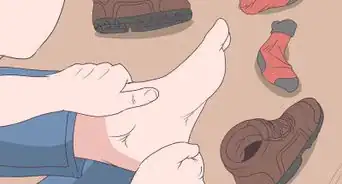This article was medically reviewed by Rebecca Levy-Gantt, MPT, DO. Dr. Rebecca Levy-Gantt is a board certified Obstetrician and Gynecologist running a private practice based in Napa, California. Dr. Levy-Gantt specializes in menopause, peri-menopause and hormonal management, including bio-Identical and compounded hormone treatments and alternative treatments. She is also a Nationally Certified Menopause Practitioner and is on the national listing of physicians who specialize in menopausal management. She received a Masters of Physical Therapy from Boston University and a Doctor of Osteopathic Medicine (DO) from the New York College of Osteopathic Medicine.
This article has been viewed 361,034 times.
All week you've been looking forward to a beach day with your friends when suddenly — hello! — you're on your period. But don't cancel just yet! With the right supplies and just a little planning, you can swim, sunbathe, and play with the rest of your friends.
Steps
Preparing
-
1Wear a menstrual cup or tampon if you plan on going swimming. A pad absolutely will not work for swimming. It will quickly absorb all the water so it won’t be able to absorb your blood, it will swell up to an embarrassing and obvious size, it won’t stay snug in your swimming suit and may slip out and float to the surface.[1] Tampons and menstrual cups collect the menstrual fluid before it even leaves your body, so the chances of leaking are pretty low.
- You can wear tampons for up to 8 hours and cups for up to 12, so you can go from sunning to swimming to playing beach volleyball without having to dash to the bathroom.
- Look for tampons labeled “active” or that are designed to be worn while playing sports. These are less likely to leak and are designed to stay put while you’re swimming, running, or lunging to catch a frisbee.
- If you’re worried about your tampon string showing, just bring a pair of nail clippers and carefully shorten the string after you insert the tampon.[2] Otherwise, just tuck it into the lining of your suit and you should be fine.
- When you enter the water, your period can stop or become very light. The pressure of the water can act like a plug or little airlock and keep the menstrual fluid inside. But this is not guaranteed to happen, and you shouldn’t count on it.
-
2Pack ample supplies. Put some back-up tampons in a little bag and then stash them in your beach bag so you’re not caught without. Your flow could be heavier than expected and you might need to change your tampon a few times, or you might stay at the beach longer than expected and run up against the 8-hour time limit for wearing a tampon safely. Bring enough so you're able to change them every 4 hours.[3]
- Keeping extra on-hand will give you peace of mind, so you can relax and enjoy yourself instead of wondering where you’re going to find a fresh tampon.
- Bringing extra tampons might end up staving the day if your friend unexpectedly gets her period or forgot to bring her own supplies.
Advertisement -
3Wear a dark colored swimsuit. This is not the time to wear your white bathing suit. There’s always a slight chance of leakage, and since you won’t be wearing a panty-liner to protect your suit from leaks, choose a suit in a dark color, like black or blue, to camouflage any accidents.[4]
- If you’re really stressing about leaks, slip on a pair of shorts or a cute sarong over your suit bottoms for an extra layer of protection.[5]
-
4Bring over-the-counter pain relievers to combat cramps. What’s worse than having menstrual cramps? Having menstrual cramps at the beach. Make sure you pack an over-the-counter (OTC) pain reliever, such as ibuprofen (Advil, Motrin) or naproxen (Aleve) and be sure to follow the package instructions. Don't forget water and snacks to take with it.[6]
- Pack warm or hot water in a thermos with a little lemon. This can increase circulation and may help your muscles relax, easing your cramps.
-
5Consider trying to skip or delay your period if you're going on vacation. If you know your week-long beach vacation falls on the same week as your period, and you use hormonal birth control, you can choose to skip your period that month or simply get it a week later. This is safe to do every once in a while and doesn’t impact the effectiveness of your birth control — though you should certainly check with your doctor.[7]
- If you take birth control pills, don’t take the inactive week of pills that you take when you get your period (they are usually marked or a different color). Instead, immediately begin a new pack.[8]
- If you use a patch or a ring, remove it after three weeks as usual. But instead of going without for a week, immediately replace it with a new one.[9]
- You may still have breakthrough bleeding when you skip your period, so you should still bring some panty liners, just in case.[10]
- If you are on birth control, make sure you have an extra pack of pills or ring or patch, in case your insurance won’t let you refill early (since you’ll need a new pack a week earlier than usual).[11]
At the Beach
-
1Drink lots of water and avoid salty foods to prevent bloating and cramps. You definitely don’t want to feel bloated and uncomfortable on a day you’re supposed to be frolicking in your swimming suit. Skip fried and super salty foods and instead snack on fruits with lots of water in them, like watermelon and berries, or calcium-rich almonds, which can reduce cramping.
- Avoid caffeine, which can make cramps worse.[12]
- Drink water, caffeine-free tea, or lemonade instead of soda or alcoholic beverages, which can increase bloating.
-
2Set up near the bathroom. You don’t need to camp out right outside the bathroom, but at least have one in sight so you know you can quickly go change or check for leaking if you need to. Also, an empty bladder and bowels can ease cramping, so visiting the bathroom frequently can help you stay comfortable.[13]
-
3Use an oil-free SPF designed specifically for faces. Lots of women break out during their periods, and an oily sunscreen can make things worse. Find sunscreen that is formulated to use on your face that won’t cause breakouts. If you’re self-conscious about pimples or redness, use a tinted moisturizer over your SPF to even out your skin tone.
- A big pair of sunglasses and a cute sunhat can also camouflage period acne. Plus, you’ll look super glamorous.
-
4Go swimming or get active to help stop cramps. It may be the last thing you feel like doing, but exercise is sometimes the best treatment for cramps. The endorphins released by your body will lift your mood and act as a natural pain killer.[14]
- If you really don’t feel like moving, elevate your feet on a stack of towels or your beach bag to help ease cramping. You can also lie on your stomach and take deep, slow breaths.
Going to the Beach When You Don’t Wear Tampons
-
1Consider getting comfortable with tampons. A lot of women are intimidated by tampons before they first try them, but they’re actually very comfortable, easy to wear, and convenient. Practice before you go to the beach (but while you are on your period—trying to wear a tampon when you don’t have your period can be painful and dangerous) so you’re feeling confident by the time you hit the water.
- Remember: tampons cannot get lost in your body. If something happens and the string comes off, it’s very easy to get the tampon out.[15] Just make sure you don’t wear your tampon longer than 8 hours and you will be totally fine.
- Some women do have difficulty inserting tampons because their hymen is too tight or the vaginal opening is too small. If you are not able to insert a tampon after several tries, see your physician.[16]
-
2Wear a pad and spend your day reading and sunbathing.[17] If you don’t plan on swimming, you may be able to get away with a thin pad in your suit. Make sure it doesn’t have wings, and check in the mirror to make sure it’s not too bulky or visible through your suit.[18]
- Wear a cute pair of shorts or a sarong around your waist, just in case your pad shows through your bathing suit.
-
3Try swimming without a pad. It’s tricky, and you may end up bleeding in the water anyway, but if you can’t wear a tampon and you’re dying to get into the water, give this a try. When you’re ready to swim, go to the bathroom to remove your pad. Slip on a pair of shorts and hustle back to the water.
- Slip out of your shorts and leave them on the sand, then quickly get into the water. It’s not foolproof, but the water may stop your period while you are swimming, or make the flow so light no one will notice.
- When you get out, immediately slip your shorts back on, grab a fresh pad, and go to the bathroom to put it in your suit. The pad may have trouble adhering to the wet material, so you may just want to change into panties and keep your shorts on.
Expert Q&A
Did you know you can get premium answers for this article?
Unlock premium answers by supporting wikiHow
-
QuestionWhile in the water, will the tampon also absorb the water, making it even bigger?
 Jennifer Boidy, RNJennifer Boidy is a Registered Nurse in Maryland. She received her Associate of Science in Nursing from Carroll Community College in 2012.
Jennifer Boidy, RNJennifer Boidy is a Registered Nurse in Maryland. She received her Associate of Science in Nursing from Carroll Community College in 2012.
Registered Nurse
-
QuestionIs it ok to go in the ocean with no pad or tampon when my period is starting to finish? Like there's blood when I wipe but not when I pee.
 Jennifer Boidy, RNJennifer Boidy is a Registered Nurse in Maryland. She received her Associate of Science in Nursing from Carroll Community College in 2012.
Jennifer Boidy, RNJennifer Boidy is a Registered Nurse in Maryland. She received her Associate of Science in Nursing from Carroll Community College in 2012.
Registered Nurse
Warnings
- Only keep a tampon in for 8 hours max! It can have a risk of TSS⧼thumbs_response⧽
- Talk to your doctor before skipping or delaying a week of your birth control to make sure it's a safe option for you at that time.⧼thumbs_response⧽
References
- ↑ https://www.ubykotex.com/get-the-facts/article?id=80600
- ↑ https://www.ubykotex.com/get-the-facts/article?id=80600
- ↑ Rebecca Levy-Gantt, MPT, DO. Board Certified Obstetrician & Gynecologist. Expert Interview. 3 April 2020.
- ↑ https://www.ubykotex.com/get-the-facts/article?id=80600
- ↑ https://www.ubykotex.com/get-the-facts/article?id=80600
- ↑ http://www.healthline.com/health-slideshow/menstrual-cramp-remedies
- ↑ http://www.womenshealthmag.com/health/how-to-skip-your-period
- ↑ http://www.womenshealthmag.com/health/how-to-skip-your-period
- ↑ http://www.womenshealthmag.com/health/how-to-skip-your-period
- ↑ http://www.womenshealthmag.com/health/how-to-skip-your-period
- ↑ http://www.womenshealthmag.com/health/how-to-skip-your-period
- ↑ http://www.glamour.com/health-fitness/blogs/vitamin-g/2013/07/4-ways-to-deal-with-your-perio
- ↑ http://www.glamour.com/health-fitness/blogs/vitamin-g/2013/07/4-ways-to-deal-with-your-perio
- ↑ http://www.healthline.com/health-slideshow/menstrual-cramp-remedies
- ↑ Rebecca Levy-Gantt, MPT, DO. Board Certified Obstetrician & Gynecologist. Expert Interview. 3 April 2020.
- ↑ http://youngwomenshealth.org/2012/09/27/tampons/
- ↑ http://www.glamour.com/health-fitness/blogs/vitamin-g/2013/07/4-ways-to-deal-with-your-perio
- ↑ http://www.glamour.com/health-fitness/blogs/vitamin-g/2013/07/4-ways-to-deal-with-your-perio
About This Article
To go to the beach on your period, you should wear a tampon or menstrual cup for swimming, which won't absorb water like pads do. If you’re experiencing cramps, swimming will release endorphins and act as a natural painkiller for your body. Additionally, try snacking on fruits with lots of water in them, like watermelon and berries, to reduce cramping and prevent bloating. Also, consider setting up near a bathroom, so you can quickly change or check for leaking if you need to. If you break out in spots during your period, try using an oil-free SPF designed for faces to keep your skin at its best. For more tips from our Medical co-author, including how to enjoy a day at the beach if you don’t wear tampons, read on!

